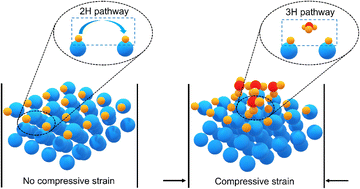The lattice strain dominated catalytic activity in single-metal nanosheets†
Abstract
Rational tailoring of highly efficient nanocatalysts is the ultimate goal of catalysis research, in which strain-engineering provides an effective method to tune the electronic structure of electrocatalysts. However, it remains difficult to clarify a definite relationship between reactivity and the strain effect due to the complicated ligand effect and synergistic effect in a multi-metal-element system. Here, porous flexible iridium nanosheets (Ir-PFNSs) with tunable compressive strain (ranging from 0 to −9.0%) were successfully obtained by directly annealing metastable 3R phase iridium oxide nanosheets in a hydrogen atmosphere, providing an ideal model electrocatalyst for studying the correlation between reactivity and lattice strain. The electrochemical results show that optimal Ir-PFNSs-300 may deliver an ultra-low overpotential of 18 mV at a current density of −10 mA cmgeo−2 with a Tafel slope of 19.5 mV dec−1 for the hydrogen evolution reaction (HER). Density functional theory (DFT) calculations indicate that iridium nanosheets with tunable compressive strain trigger a new three-hydrogen pathway for the HER. This work successfully establishes a definite correlation between reactivity and lattice strain.

- This article is part of the themed collection: Journal of Materials Chemistry A HOT Papers


 Please wait while we load your content...
Please wait while we load your content...